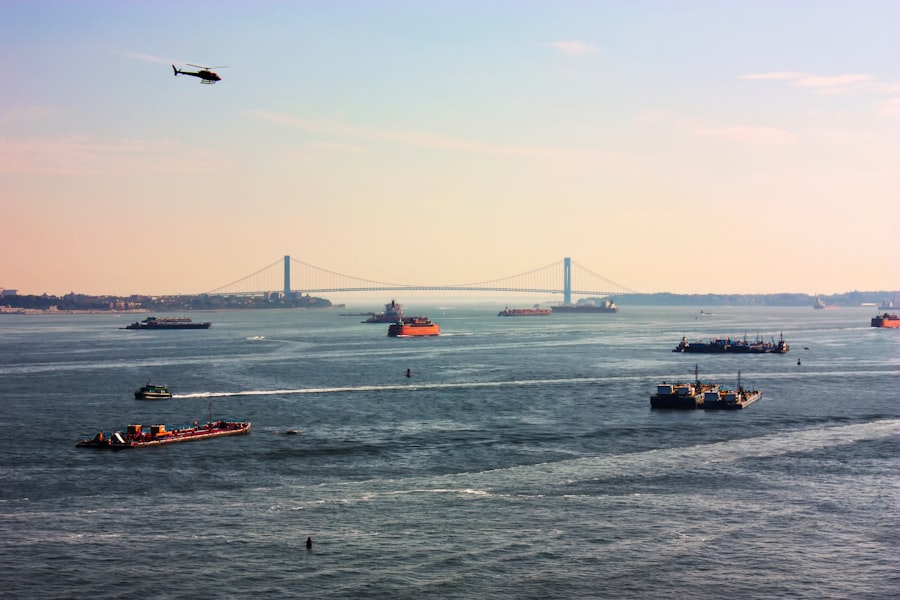Flight training is not merely a series of lessons; it is a transformative journey that opens the door to the skies. For many, the dream of flying is rooted in a deep-seated desire for freedom and adventure. The importance of flight training cannot be overstated, as it equips aspiring pilots with the necessary skills, knowledge, and confidence to operate an aircraft safely and effectively.
Through structured training programs, students learn not only the mechanics of flying but also the critical decision-making skills required in high-pressure situations. Moreover, flight training fosters a sense of discipline and responsibility. Pilots are entrusted with the safety of their passengers and crew, making it imperative that they understand the complexities of aviation.
This training instills a strong foundation in aerodynamics, navigation, and meteorology, ensuring that pilots are well-prepared for any scenario they may encounter in the air. As such, flight training is essential not just for personal achievement but also for maintaining the high safety standards that the aviation industry demands.
Key Takeaways
- Flight training is crucial for aspiring pilots to gain the necessary skills and knowledge for safe and successful flying.
- When choosing a flight school, consider factors such as accreditation, instructor experience, and available resources.
- Understanding the basics of flight, including aerodynamics and aircraft controls, is essential for all pilots.
- Navigating New York’s airspace requires knowledge of local regulations, communication procedures, and navigation techniques.
- Mastering takeoff and landing is a fundamental skill that all pilots must develop through practice and training.
Choosing the Right Flight School
Selecting the right flight school is a pivotal step in your aviation journey. With numerous options available, it can be overwhelming to determine which institution aligns best with your goals and aspirations. Factors such as location, cost, aircraft availability, and instructor qualifications should all be considered when making your choice.
A reputable flight school will offer a comprehensive curriculum that covers both ground school and flight instruction, ensuring that students receive a well-rounded education. Additionally, prospective students should seek out schools with a strong safety record and positive reviews from former students. Visiting the school in person can provide valuable insights into the facilities and aircraft used for training.
Engaging with instructors and current students can also help gauge the school’s culture and support system. Ultimately, choosing the right flight school is about finding an environment that fosters growth, learning, and a passion for aviation.
Understanding the Basics of Flight

Before taking to the skies, it is crucial to grasp the fundamental principles of flight. Understanding how an aircraft operates involves delving into concepts such as lift, thrust, drag, and weight. Lift is generated by the wings as air flows over them, while thrust propels the aircraft forward.
Conversely, drag acts against the aircraft’s motion, and weight pulls it downward due to gravity. Mastering these concepts is essential for any aspiring pilot. In addition to aerodynamics, students must familiarize themselves with aircraft systems and controls.
This includes understanding how to operate the cockpit instruments, navigation systems, and communication devices. Ground school provides an excellent foundation for this knowledge, allowing students to learn about air traffic control procedures, weather patterns, and flight planning. By building a solid understanding of these basics, aspiring pilots can approach their flight training with confidence and clarity.
Navigating New York’s Airspace
| Metrics | Data |
|---|---|
| Number of Airports | 3 |
| Number of Air Traffic Control Towers | 4 |
| Number of Airspace Classes | 5 |
| Busiest Airport | John F. Kennedy International Airport |
| Busiest Airspace Sector | New York Approach Control |
Flying in New York presents unique challenges due to its complex airspace structure. The region is home to several major airports, including JFK, LaGuardia, and Newark Liberty International Airport, all of which contribute to a bustling air traffic environment. Understanding how to navigate this airspace is crucial for any pilot training in the area.
Students must learn about controlled and uncontrolled airspace, as well as the various air traffic control procedures that govern operations in busy metropolitan areas. Moreover, New York’s airspace is subject to specific regulations and restrictions that pilots must adhere to. Familiarity with these rules ensures safe operations and helps prevent potential conflicts with other aircraft.
Flight schools in New York often incorporate local airspace navigation into their training programs, providing students with practical experience in managing their flight paths amidst heavy traffic. This knowledge not only enhances safety but also builds confidence in handling complex flying scenarios.
Mastering Takeoff and Landing
Takeoff and landing are arguably the most critical phases of flight, requiring precision and skill from pilots. Mastering these maneuvers is essential for ensuring a safe flying experience. During takeoff, pilots must carefully manage engine power, control surfaces, and runway alignment to achieve a smooth ascent into the sky.
This phase requires a keen understanding of aircraft performance characteristics and environmental factors such as wind speed and direction. Landing presents its own set of challenges, as pilots must execute a controlled descent while maintaining situational awareness of their surroundings. The approach must be stable and well-timed to ensure a safe touchdown on the runway.
Flight training emphasizes repetitive practice of these maneuvers under various conditions to build muscle memory and confidence. With each successful takeoff and landing, aspiring pilots gain invaluable experience that prepares them for real-world flying scenarios.
Learning to Fly in Different Weather Conditions

Weather plays a significant role in aviation safety and performance. As such, learning to fly in different weather conditions is an integral part of flight training. Pilots must develop an understanding of how various weather phenomena—such as rain, fog, wind shear, and thunderstorms—affect aircraft performance and safety.
This knowledge enables pilots to make informed decisions about when to fly or when to postpone a flight due to adverse conditions. Flight schools often incorporate simulated weather scenarios into their training programs to prepare students for real-life situations. By practicing in controlled environments that mimic challenging weather conditions, aspiring pilots can learn how to adapt their flying techniques accordingly.
This experience not only enhances their skills but also instills a sense of confidence in their ability to handle unexpected weather changes during actual flights.
Advanced Maneuvers and Techniques
Once students have mastered the basics of flying, they can begin exploring advanced maneuvers and techniques that enhance their piloting skills. These may include aerobatic maneuvers, steep turns, stalls, and emergency procedures. Each of these techniques requires a deep understanding of aircraft dynamics and control inputs, making them essential components of advanced flight training.
Aerobatic maneuvers are particularly exciting for many pilots as they push the limits of both the aircraft and the pilot’s abilities. However, they also require rigorous training and practice to ensure safety during execution. Similarly, mastering emergency procedures prepares pilots for unexpected situations that may arise during flight.
By honing these advanced skills, pilots not only become more proficient but also gain greater confidence in their ability to handle diverse flying scenarios.
Obtaining Your Pilot’s License
The culmination of flight training is obtaining your pilot’s license—a significant milestone that represents your dedication and hard work in mastering the art of flying. The process typically involves passing both written exams and practical flight tests administered by aviation authorities. Students must demonstrate their knowledge of aviation regulations, navigation procedures, meteorology, and aircraft systems during these assessments.
The freedom that comes with holding a pilot’s license is unparalleled; it allows individuals to explore new destinations from above while experiencing the thrill of flight firsthand. However, obtaining a pilot’s license also comes with ongoing responsibilities—pilots must continue their education through recurrent training and stay informed about changes in regulations or best practices within the aviation industry.
In conclusion, embarking on a journey through flight training is an exhilarating experience filled with challenges and rewards alike. From understanding the basics of flight to mastering advanced techniques and ultimately obtaining your pilot’s license, each step brings you closer to realizing your dream of soaring through the skies. Further Reading:
1.
[Federal Aviation Administration (FAA)](https://www.faa.gov)
2. [AOPA – Aircraft Owners and Pilots Association](https://www.
org)
3. [Pilot Institute](https://pilotinstitute.com)
4.
[Flight Training Magazine](https://www.flighttraining.aopa.org)
5. [National Association of Flight Instructors](https://www.nafinet.org) And here’s a kid-friendly joke for you: Why did the airplane get sent to its room? Because it had a bad altitude!
If you are interested in flight training in New York, you may want to check out this article on the services offered by Learn2FlyNYC. This article provides detailed information on the various training programs available, including private pilot training, instrument rating, and commercial pilot training. It also highlights the experienced instructors and state-of-the-art equipment used in the training process. For more information on how to get started with flight training in New York, you can also visit their contact us page.
Book Your Discovery Flight In NYC Right Now! Seats fill up fast!
FAQs
What is flight training?
Flight training is the process of learning how to operate an aircraft. It involves both ground school, where students learn about aviation theory, and flight training, where students learn to operate an aircraft in the air.
What are the requirements for flight training in New York?
In New York, the requirements for flight training include being at least 16 years old to solo, 17 years old to obtain a private pilot certificate, and 18 years old to obtain a commercial pilot certificate. Additionally, students must pass a medical exam, complete a certain number of flight hours, and pass written and practical exams.
Where can I find flight training in New York?
There are several flight training schools and academies in New York that offer flight training programs. These can be found at local airports and aviation centers.
What are the different types of flight training programs available in New York?
In New York, flight training programs include private pilot training, instrument rating training, commercial pilot training, and flight instructor training. There are also specialized programs for advanced ratings and endorsements.
How long does it take to complete flight training in New York?
The duration of flight training in New York can vary depending on the type of program and the student’s availability. On average, it can take anywhere from a few months to a year to complete flight training and obtain a pilot certificate.

